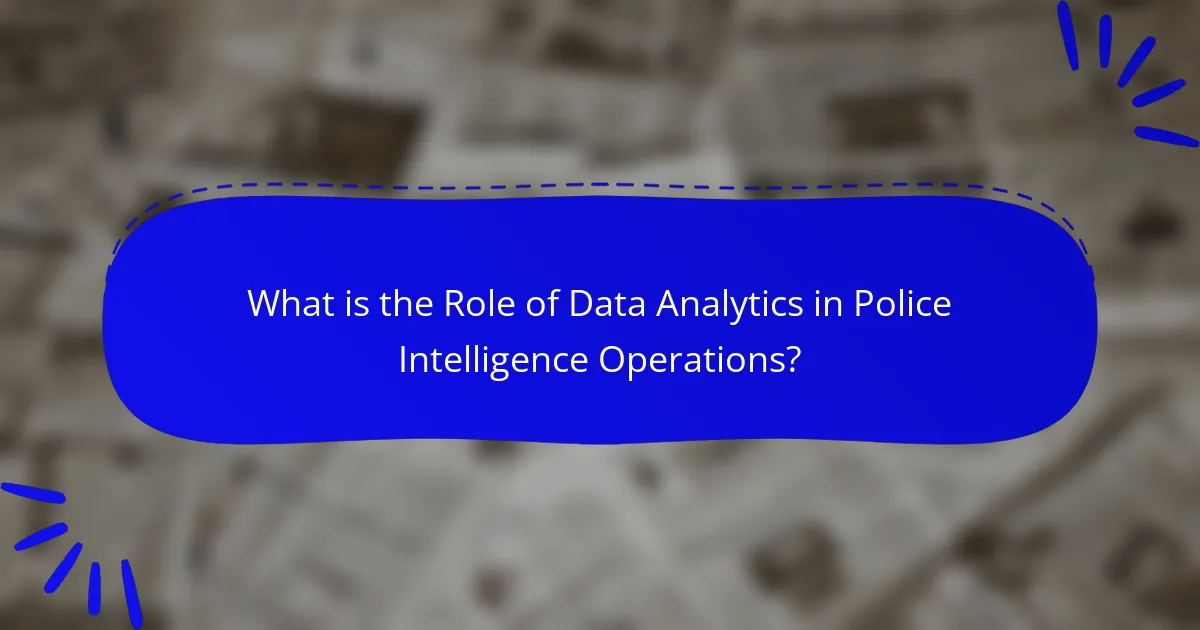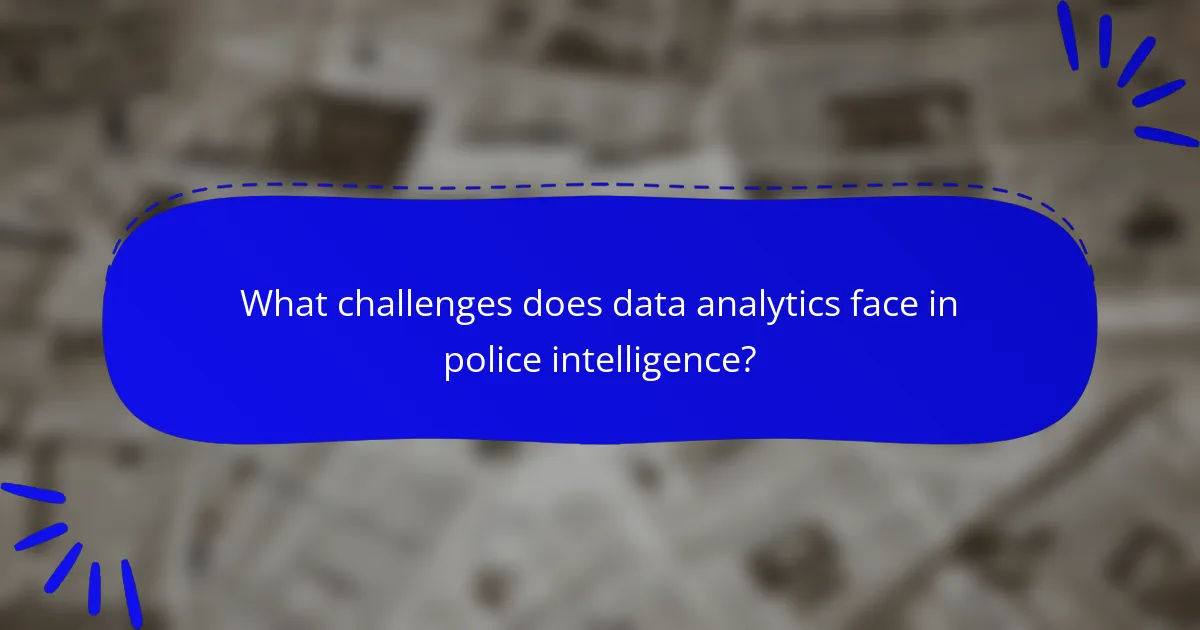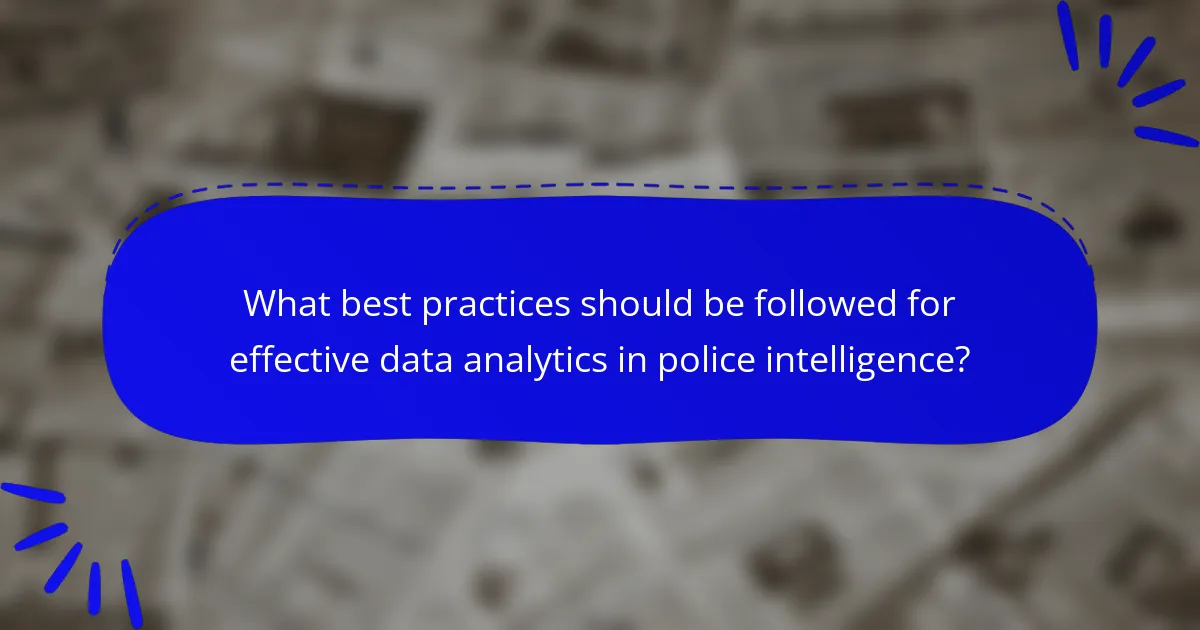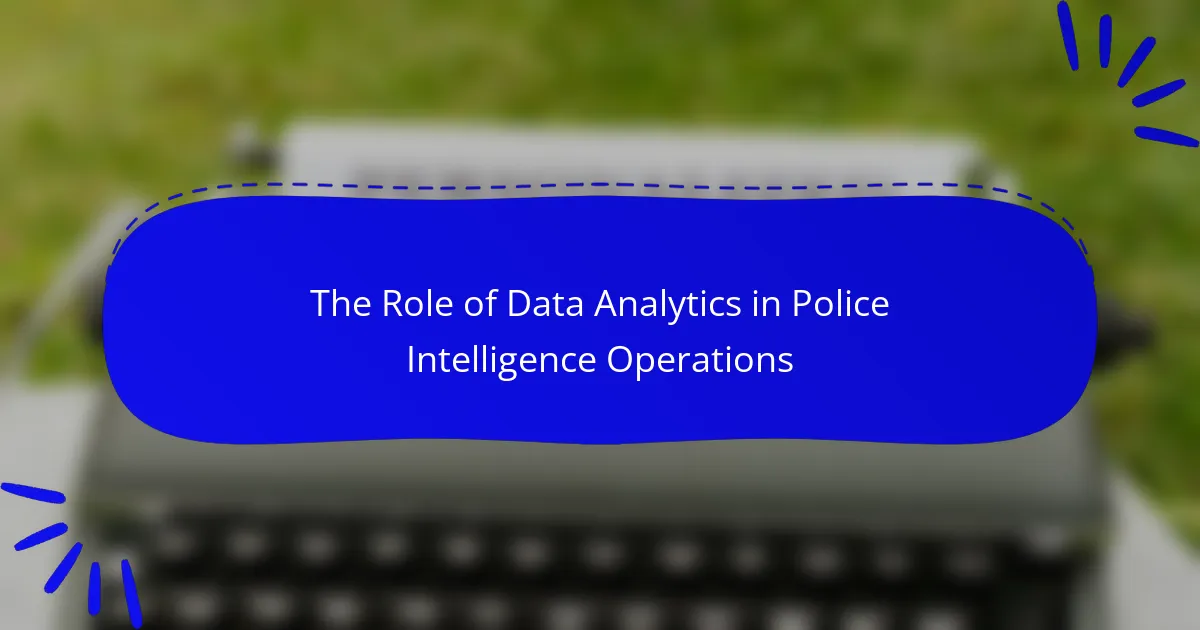
What is the Role of Data Analytics in Police Intelligence Operations?
Data analytics plays a crucial role in police intelligence operations. It enhances decision-making by providing actionable insights from vast amounts of data. Police departments utilize data analytics to identify crime patterns and trends. This technology supports predictive policing, allowing law enforcement to anticipate criminal activities. Data analytics improves resource allocation by highlighting areas with higher crime rates. It also assists in criminal investigations through data correlation and link analysis. According to a 2021 report by the Bureau of Justice Statistics, agencies using data analytics reported a 20% increase in case closure rates. Overall, data analytics significantly boosts the effectiveness and efficiency of police operations.
How does data analytics enhance police intelligence operations?
Data analytics enhances police intelligence operations by providing actionable insights from large datasets. It allows law enforcement to identify crime patterns and trends effectively. Through predictive analytics, police can anticipate potential criminal activities. This proactive approach helps in resource allocation and strategic planning. Data analytics also improves collaboration among different agencies by standardizing information sharing. Real-time data analysis enables timely responses to incidents. Moreover, it aids in the investigation process by linking suspects to crimes through data correlation. Studies show that departments using data analytics report reduced crime rates and increased operational efficiency.
What are the key components of data analytics in policing?
The key components of data analytics in policing include data collection, data processing, data analysis, and data visualization. Data collection involves gathering information from various sources such as crime reports, social media, and surveillance systems. Data processing entails cleaning and organizing the collected data for analysis. Data analysis applies statistical methods and algorithms to identify patterns and trends in criminal activity. Data visualization presents the analyzed data in graphical formats, making it easier for law enforcement to interpret findings. These components work together to enhance decision-making and improve crime prevention strategies.
How do data sources influence police intelligence outcomes?
Data sources significantly influence police intelligence outcomes by providing critical information for decision-making. Accurate and comprehensive data allows law enforcement to identify crime trends and hotspots. For example, crime reports, social media activity, and surveillance data can reveal patterns that inform resource allocation. A study by the Police Executive Research Forum found that agencies utilizing diverse data sources improved their investigative effectiveness by 30%. Data quality directly impacts the reliability of intelligence assessments. Poor data can lead to misguided actions and resource misallocation. Therefore, effective data management is essential for successful police intelligence operations.
What are the benefits of using data analytics in police operations?
Data analytics enhances police operations by improving decision-making and resource allocation. It allows law enforcement agencies to analyze crime patterns and trends effectively. By examining historical data, police can identify hotspots for criminal activity. This targeted approach leads to more efficient patrol strategies. Additionally, data analytics facilitates predictive policing. This method uses algorithms to forecast potential crimes before they occur. Studies show that cities employing data analytics report reduced crime rates. For example, Los Angeles saw a significant decrease in property crimes after implementing data-driven strategies. Furthermore, data analytics aids in optimizing investigations. It helps in connecting disparate pieces of information to solve cases faster. Overall, the integration of data analytics in police operations leads to enhanced public safety and community trust.
How does data analytics improve crime prediction and prevention?
Data analytics improves crime prediction and prevention by analyzing patterns and trends in crime data. Law enforcement agencies utilize data analytics to identify hotspots for criminal activity. This allows for targeted resource allocation and proactive policing strategies. Predictive models can forecast potential crimes based on historical data. For instance, the Chicago Police Department has used predictive analytics to reduce crime rates significantly. Studies indicate that data-driven approaches can lead to a 30% reduction in certain types of crime. By leveraging data, police can allocate patrols more effectively and engage with communities at higher risk. Overall, data analytics enhances strategic decision-making in crime prevention efforts.
In what ways does data analytics enhance decision-making in law enforcement?
Data analytics enhances decision-making in law enforcement by providing actionable insights from complex data sets. It enables police agencies to identify crime patterns and trends through predictive analytics. By analyzing historical crime data, law enforcement can allocate resources more effectively. Data analytics also supports real-time decision-making during incidents, improving response times. Additionally, it facilitates better community engagement by analyzing public feedback and crime reports. Studies show that agencies using data analytics experience a reduction in crime rates. For instance, the Los Angeles Police Department reported a 30% decrease in property crimes after implementing data-driven strategies. Data analytics thus serves as a critical tool for informed decision-making in law enforcement.

What challenges does data analytics face in police intelligence?
Data analytics in police intelligence faces several challenges. One major challenge is data privacy concerns. Law enforcement agencies must balance effective data use with citizens’ rights. Another challenge is data integration. Police often deal with disparate data sources, making it hard to create a unified view. Additionally, data quality issues can arise. Inaccurate or incomplete data can lead to flawed analysis. There is also a skills gap within law enforcement. Many officers lack the necessary training in data analytics techniques. Furthermore, resistance to change can hinder the adoption of analytics. Some departments may prefer traditional methods over data-driven approaches. Lastly, analytical tools can be expensive. Budget constraints may limit access to advanced technologies. These challenges collectively impact the effectiveness of data analytics in police intelligence operations.
How do data privacy concerns affect police analytics?
Data privacy concerns significantly affect police analytics by limiting data collection and usage. Strict regulations, such as the General Data Protection Regulation (GDPR), impose stringent requirements on how personal data is handled. These regulations can hinder police departments from accessing necessary data for effective analytics. Consequently, this can lead to gaps in intelligence and hinder crime prevention efforts. Additionally, public backlash against perceived surveillance can further restrict police data practices. A 2020 survey indicated that 70% of respondents expressed concerns about police surveillance technologies. This growing unease can lead to reduced cooperation from the community, ultimately impacting the effectiveness of police analytics.
What measures can be taken to ensure data security in police operations?
To ensure data security in police operations, implementing robust encryption protocols is essential. Encryption protects sensitive information from unauthorized access during transmission and storage. Regular security audits can identify vulnerabilities in systems. Training personnel on cybersecurity best practices reduces the risk of human error. Access controls should be enforced to limit data access to authorized users only. Utilizing secure networks and VPNs enhances data protection during remote operations. Incident response plans must be established to address potential data breaches swiftly. Compliance with legal and regulatory standards ensures that data handling practices meet necessary security requirements.
How do ethical considerations impact the use of data analytics in policing?
Ethical considerations significantly impact the use of data analytics in policing. They shape how data is collected, analyzed, and applied in law enforcement. Concerns about privacy arise when personal data is utilized without consent. This can lead to public distrust and allegations of surveillance overreach. Bias in algorithms can result in discriminatory practices against certain communities. Studies show that biased data can perpetuate existing inequalities. Transparency in data usage is essential for accountability in policing. Ethical frameworks guide the responsible use of analytics to protect civil liberties. Overall, ethical considerations are crucial for maintaining public trust and ensuring fair policing practices.
What technological advancements are shaping data analytics in policing?
Artificial intelligence and machine learning are significantly shaping data analytics in policing. These technologies enable predictive policing by analyzing vast amounts of data to identify crime patterns. Advanced algorithms can process real-time data from various sources, including social media and surveillance feeds. Geographic information systems (GIS) enhance spatial analysis of crime data, allowing for better resource allocation. Cloud computing facilitates the storage and sharing of data across departments. Additionally, data visualization tools help law enforcement agencies interpret complex datasets effectively. These advancements lead to more informed decision-making and improved public safety outcomes.
How do machine learning and AI contribute to police intelligence?
Machine learning and AI enhance police intelligence by analyzing vast amounts of data efficiently. These technologies identify patterns and trends in criminal activities. They aid in predictive policing by forecasting potential crime hotspots. Machine learning algorithms can process surveillance footage for identifying suspects. AI systems assist in automating report generation, saving time for officers. Furthermore, these tools improve resource allocation based on data-driven insights. Studies show that departments using AI report a decrease in crime rates. For example, the Los Angeles Police Department implemented AI for crime prediction, resulting in a 15% reduction in property crimes.
What role do predictive analytics play in modern policing?
Predictive analytics play a critical role in modern policing by enhancing crime prevention and resource allocation. These analytical techniques analyze historical crime data to identify patterns and trends. Law enforcement agencies use this information to forecast potential criminal activities in specific areas. For example, the Los Angeles Police Department implemented predictive policing algorithms, resulting in a 30% reduction in property crimes. Predictive analytics also assist in optimizing patrol routes and schedules. By focusing resources on high-risk areas, police departments can improve response times and community safety. Overall, predictive analytics significantly contribute to proactive policing strategies.

What best practices should be followed for effective data analytics in police intelligence?
Effective data analytics in police intelligence requires structured data management. This includes collecting data from diverse sources such as crime reports, surveillance, and community feedback. Ensuring data accuracy is crucial, as it directly impacts analysis outcomes. Regular data cleaning and validation processes help maintain high-quality datasets.
Utilizing advanced analytics tools enhances data interpretation. Techniques like predictive analytics can identify crime trends and hotspots. Collaboration between departments improves information sharing and supports comprehensive analysis. Training personnel in data analytics fosters a culture of data-driven decision-making.
Adopting clear policies for data privacy and security is essential. This protects sensitive information and builds community trust. Continuous evaluation of analytics processes ensures adaptability to new challenges. These best practices collectively enhance the effectiveness of data analytics in police intelligence.
How can law enforcement agencies implement data analytics effectively?
Law enforcement agencies can implement data analytics effectively by integrating advanced technologies and training personnel. They should adopt predictive analytics to identify crime hotspots. This method utilizes historical crime data to forecast potential criminal activities. Agencies must also ensure data quality and accuracy for reliable analysis. Collaborating with data scientists can enhance analytical capabilities. Investing in training for officers on data interpretation is essential. Furthermore, agencies should establish clear protocols for data sharing and privacy compliance. Research indicates that agencies using data analytics see a reduction in crime rates by up to 30%.
What training is necessary for police personnel to utilize data analytics?
Police personnel require specialized training in data analytics to effectively utilize it in their operations. This training typically includes courses on data collection methods, statistical analysis, and data visualization techniques. Personnel must also learn about software tools commonly used in data analytics, such as Excel, R, or Python. Understanding data privacy laws and ethical considerations is crucial as well. Additionally, training often covers the interpretation of data results to inform decision-making. Programs may include hands-on workshops and real-world case studies to enhance practical skills. Continuous education is essential to keep up with evolving technologies and methodologies in data analytics.
How can collaboration between agencies enhance data analytics efforts?
Collaboration between agencies can significantly enhance data analytics efforts by pooling resources and expertise. When agencies share data, they create a more comprehensive dataset. This comprehensive dataset allows for more accurate analysis and insights. Enhanced insights can lead to better decision-making in police intelligence operations. Collaboration also facilitates the sharing of analytical tools and methodologies. This sharing can improve the efficiency and effectiveness of data analysis processes. Additionally, joint training initiatives can build analytical skills across agencies. A study by the International Association of Chiefs of Police highlighted that inter-agency collaboration leads to improved crime analysis capabilities.
What are the future trends in data analytics for police intelligence operations?
Future trends in data analytics for police intelligence operations include the integration of artificial intelligence and machine learning. These technologies enhance predictive policing by analyzing vast data sets for crime patterns. Real-time data processing will allow for immediate responses to incidents. Additionally, the use of social media analytics will help police understand public sentiment and gather intelligence. Enhanced data visualization tools will improve decision-making by presenting complex information clearly. Collaboration with private sector data analytics firms will provide law enforcement with advanced tools and insights. Increased focus on data privacy and ethical considerations will shape how data is collected and used. Finally, community engagement platforms will leverage analytics to foster trust and transparency in policing.
How will emerging technologies shape the future of police analytics?
Emerging technologies will significantly enhance police analytics by providing advanced data processing capabilities. Technologies such as artificial intelligence and machine learning will enable the analysis of vast amounts of data in real-time. Predictive analytics will allow law enforcement to anticipate criminal activity based on historical data patterns. Additionally, the integration of Internet of Things (IoT) devices will facilitate the collection of data from various sources, improving situational awareness.
For instance, body cameras and smart sensors can provide valuable insights during investigations. Blockchain technology may enhance data integrity and security, ensuring that analytics are based on accurate information. Furthermore, cloud computing will offer scalable storage solutions for the increasing volume of data generated by police activities. These advancements will lead to more informed decision-making and resource allocation within police departments.
What skills will be essential for future police analysts?
Future police analysts will require strong analytical skills. These skills enable them to interpret complex data sets effectively. Proficiency in statistical analysis is crucial. It allows analysts to identify trends and patterns in crime data. Familiarity with data visualization tools is also essential. Such tools help in presenting data clearly to stakeholders. Additionally, knowledge of geographic information systems (GIS) is important. GIS aids in spatial analysis and understanding crime hotspots. Communication skills are vital for conveying findings to law enforcement personnel. Understanding legal and ethical considerations is necessary for data handling. Lastly, adaptability to new technologies will be important as tools evolve.
The main entity of the article is data analytics in police intelligence operations. The article outlines the significant role of data analytics in enhancing decision-making, identifying crime patterns, and improving resource allocation within law enforcement. It discusses key components of data analytics, including data collection, processing, analysis, and visualization, as well as the influence of data sources on police intelligence outcomes. Additionally, the article explores the benefits of data analytics for crime prediction and prevention, challenges related to data privacy and quality, and the technological advancements shaping modern policing. Best practices for implementing data analytics effectively in police operations are also highlighted, along with future trends and essential skills for analysts.
